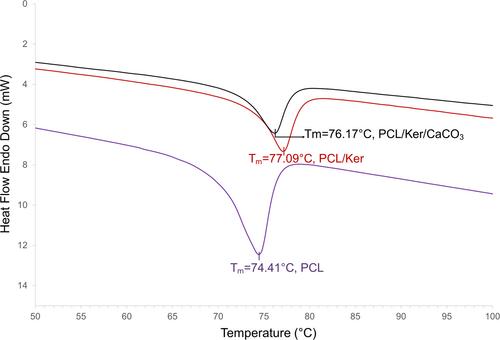下载PDF
{"title":"Sustainable biomaterials for tissue engineering: electrospun polycaprolactone fibers enriched with freshwater snail calcium carbonate and waste human hair keratin","authors":"Özge Erdemli, Bengi Yilmaz, İrem Göksu Saran, Erdal Serin","doi":"10.1002/pi.6667","DOIUrl":null,"url":null,"abstract":"<p>This study focuses on developing a sustainable and biocompatible polycaprolactone (PCL)-based scaffold for bone tissue engineering through electrospinning, utilizing calcium carbonate (CaCO<sub>3</sub>) from <i>Pomacea canaliculata</i> shells and keratin from human hair, known for stimulating bone regeneration. The isolated CaCO<sub>3</sub> has been identified to demonstrate two polymorphs, vaterite and calcite, as determined by X-ray diffraction. The isolation of keratin from human hair was confirmed through sodium dodecyl sulfate polyacrylamide gel electrophoresis and Fourier transform infrared spectroscopy analysis, revealing the presence of <i>α</i>-keratin structures around 45–50 kDa and <i>β</i>-keratin structures around 55–60 kDa. According to scanning electron microscope observations, the addition of keratin to PCL fibers reduced their diameter from 457 ± 345 to 371 ± 103 nm. Further addition of calcium carbonate led to a mean diameter of 258 ± 76 nm. The melting temperature of PCL fibers containing keratin and CaCO<sub>3</sub> was determined to be 76.17 °C via differential scanning calorimetry, while thermogravimetric analysis, conducted at temperatures up to 600 °C, revealed a remaining ash content of 9.59%. Calcium phosphate accumulation was observed to initiate on PCL fibers containing keratin and CaCO<sub>3</sub> following a 7-day exposure to simulated body fluid. The fibers exhibit cytocompatibility, showing no toxicity while supporting the growth and proliferation of Saos-2 osteosarcoma cells. The results suggest that the innovative incorporation of keratin and CaCO<sub>3</sub> into PCL nanofibers could serve as a bioactive matrix compared to pure PCL matrices, thereby offering enhanced potential for bone tissue engineering applications. © 2024 The Author(s). <i>Polymer International</i> published by John Wiley & Sons Ltd on behalf of Society of Chemical Industry.</p>","PeriodicalId":20404,"journal":{"name":"Polymer International","volume":"73 10","pages":"833-843"},"PeriodicalIF":2.9000,"publicationDate":"2024-06-03","publicationTypes":"Journal Article","fieldsOfStudy":null,"isOpenAccess":false,"openAccessPdf":"https://onlinelibrary.wiley.com/doi/epdf/10.1002/pi.6667","citationCount":"0","resultStr":null,"platform":"Semanticscholar","paperid":null,"PeriodicalName":"Polymer International","FirstCategoryId":"92","ListUrlMain":"https://onlinelibrary.wiley.com/doi/10.1002/pi.6667","RegionNum":4,"RegionCategory":"化学","ArticlePicture":[],"TitleCN":null,"AbstractTextCN":null,"PMCID":null,"EPubDate":"","PubModel":"","JCR":"Q2","JCRName":"POLYMER SCIENCE","Score":null,"Total":0}
引用次数: 0
引用
批量引用
Abstract
This study focuses on developing a sustainable and biocompatible polycaprolactone (PCL)-based scaffold for bone tissue engineering through electrospinning, utilizing calcium carbonate (CaCO3 ) from Pomacea canaliculata shells and keratin from human hair, known for stimulating bone regeneration. The isolated CaCO3 has been identified to demonstrate two polymorphs, vaterite and calcite, as determined by X-ray diffraction. The isolation of keratin from human hair was confirmed through sodium dodecyl sulfate polyacrylamide gel electrophoresis and Fourier transform infrared spectroscopy analysis, revealing the presence of α -keratin structures around 45–50 kDa and β -keratin structures around 55–60 kDa. According to scanning electron microscope observations, the addition of keratin to PCL fibers reduced their diameter from 457 ± 345 to 371 ± 103 nm. Further addition of calcium carbonate led to a mean diameter of 258 ± 76 nm. The melting temperature of PCL fibers containing keratin and CaCO3 was determined to be 76.17 °C via differential scanning calorimetry, while thermogravimetric analysis, conducted at temperatures up to 600 °C, revealed a remaining ash content of 9.59%. Calcium phosphate accumulation was observed to initiate on PCL fibers containing keratin and CaCO3 following a 7-day exposure to simulated body fluid. The fibers exhibit cytocompatibility, showing no toxicity while supporting the growth and proliferation of Saos-2 osteosarcoma cells. The results suggest that the innovative incorporation of keratin and CaCO3 into PCL nanofibers could serve as a bioactive matrix compared to pure PCL matrices, thereby offering enhanced potential for bone tissue engineering applications. © 2024 The Author(s). Polymer International published by John Wiley & Sons Ltd on behalf of Society of Chemical Industry.
用于组织工程的可持续生物材料:富含淡水蜗牛碳酸钙和废人类头发角蛋白的电纺聚己内酯纤维
本研究的重点是通过电纺丝技术,利用从 Pomacea canaliculata 贝壳中提取的碳酸钙(CaCO3)和从人类头发中提取的角蛋白(众所周知,角蛋白可刺激骨再生),开发一种可持续且生物相容性良好的聚己内酯(PCL)基支架,用于骨组织工程。经 X 射线衍射测定,分离出的 CaCO3 有两种多晶体,即醋酸盐和方解石。十二烷基硫酸钠聚丙烯酰胺凝胶电泳和傅立叶变换红外光谱分析证实了从人类头发中分离出的角蛋白,显示存在 45-50 kDa 左右的 α 角蛋白结构和 55-60 kDa 左右的 β 角蛋白结构。根据扫描电子显微镜观察,在 PCL 纤维中添加角蛋白后,其直径从 457 ± 345 nm 减小到 371 ± 103 nm。进一步添加碳酸钙后,其平均直径为 258 ± 76 nm。通过差示扫描量热仪测定,含有角蛋白和 CaCO3 的 PCL 纤维的熔化温度为 76.17 °C,而在高达 600 °C 的温度下进行的热重分析显示,剩余灰分含量为 9.59%。在模拟体液中暴露 7 天后,观察到磷酸钙在含有角蛋白和 CaCO3 的 PCL 纤维上开始积累。这种纤维具有细胞相容性,在支持 Saos-2 骨肉瘤细胞生长和增殖的同时没有显示出毒性。研究结果表明,与纯 PCL 基质相比,在 PCL 纳米纤维中创新性地加入角蛋白和 CaCO3 可作为一种生物活性基质,从而为骨组织工程应用提供更大的潜力。© 2024 作者。国际聚合物》由 John Wiley & Sons Ltd 代表化学工业协会出版。
本文章由计算机程序翻译,如有差异,请以英文原文为准。



